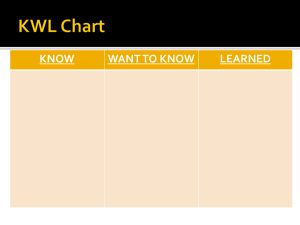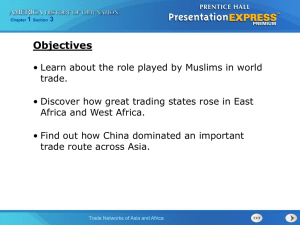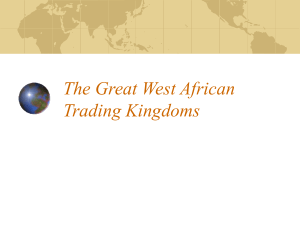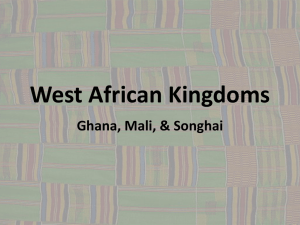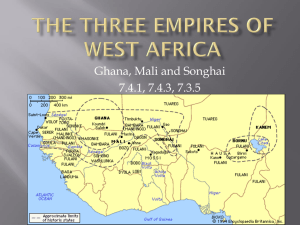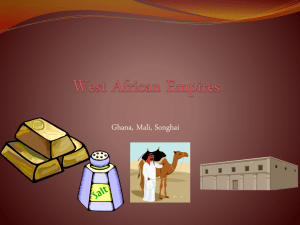File
advertisement
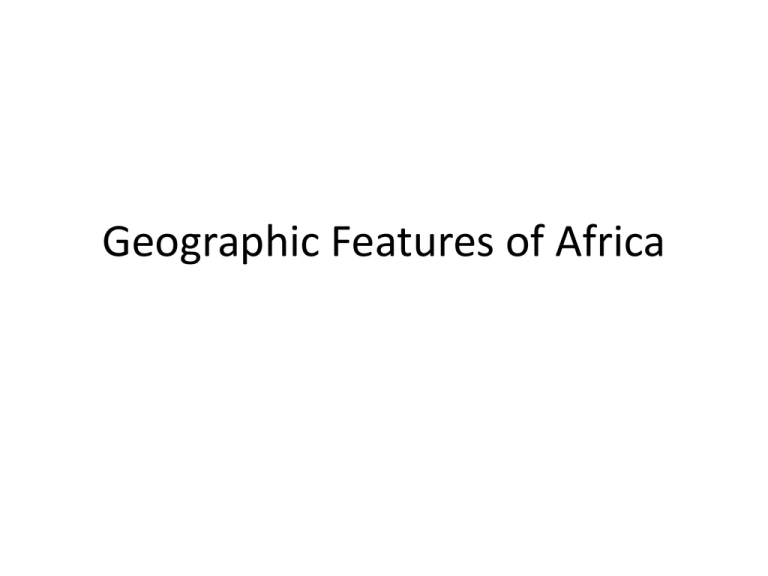
Geographic Features of Africa A Satellite View African Geography • Second largest continent of Earth • Africa’s climate and landforms influenced the ways in which its people live • Northern Africa: Sahara desert, Atlas Mountains • North East Africa: Nile River, Red Sea • East Africa: lakes, plateaus (flat land) and Great Rift Valley (mountains) • Middle Africa: Congo River Basin, tropical rain forests, many species of animals Vegetation Zones Great Rift Valley 3,000 miles long Climate • Four Climate Zones – Mild-stretches across northern coast and southern tip. Moderate rainfall, warm temps, fertile land – Desert-covers 40% of Africa, Sahara desert in the north, Kalahari in the south – Rain forest-stretches across of Africa along the equator, makes up 10% of land, heavy rains, warm temps, dense forests, hard to travel through – Savannas-broad grasslands, small shrubs, covers 40% of Africa, located north and south of rainforest. gets enough rainfall for farming/herding but rain is unreliable Kush & Axum • Kush & Axum arose as strong early civilizations • Kush: 2000 B.C., because of all the trade going on in Egypt, Arabs established and turned into a state • Economy based on farming, because of its location along the Nile River • Major trading empire: provided iron products, ivory, gold, ebony, and slaves Axum • 250 B .C.- Located along Africa’s east coast (along the Red Sea) • Was located along a trade route to India & Mediterranean • Religion was Christianity, Islamic rulers moved into the area and a new religion moved in (Islam) Rise of Islam • Islam also impacted Africa. By the early eighth century, the coastal region of North Africa was under Arab rule. • Several Muslim trading states had been established on the African coast of the Red Sea • Why is farming a necessary first step toward founding a civilization? • (Farming allows for larger population to settle in an area; settled populations can develop the characteristics of a civilization.) What is “Dar al-Islam”? • The collective regions of Islam – “ Islam-dom” (cf. Christendom) The Royal Kingdoms of West Africa (Ghana, Mali, Songhai WEST AFRICAN SALT-GOLD KINGDOMS • GHANA • MALI • SONGHAI Ghana • Ghana, in the upper Niger River valley, emerged in the fifth century as one of the first great trading states of West Africa. • The Kings of Ghana were wealthy and relied on a welltrained army to enforce their wishes • Ghana had an abundance of gold, making it the center of an enormous trade empire • In exchange for gold, Muslim merchants from North Africa brought textiles, metal goods, horses, and salt. Salt, used for preserving food, was also very important for replacing salt lost from the body due to the hot climate. Ghana became a rich and powerful nation, especially when the camel began to be used as a source of transport. Ghana relied on trade and trade was made faster and bigger with the use of the camel. http://es.encarta.msn.com/media_461532998_761558787_-1_1/Caravana_de_camellos.html news.nationalgeographic.com/. ../salt/photo6.html Berbers & Decline of Ghana • Berbers, a nomadic people, used camel caravans to carry out much of the trade across the desert. Camels were well adapted to desert conditions. • The kingdom of Ghana, weakened by wars, collapsed around 1200. • One of the greatest of the trading states that arose in its place was Mali, established by Sundiata Keita in the mid-thirteenth century. Mali • Sundiata captured the Ghanaian capital in 1240. He united the people of Mali and created a strong government. • The wealth and power of Mali was based on the gold and salt trade; however, most people in Mali were grain farmers. • Mansa Musa, who ruled Mali from 1307 to 1337, was a rich and powerful king. He doubled the size of the kingdom and created a strong central government. • MANSA MUSA: Greatest King of Mali - Hajj to Mecca; Introduced Islamic culture to Mali Mansa Musa’s haj Mali on the Map” Mansa Musa “put Mali Culture • Rulers became Muslim • prosperous kingdom • Timbuktu became center of learning (university) &Islamic cultural center contained Muslim art, mosques • Evidence of trip to the Americas? • His pilgrimage to Makkah was accompanied by thousand of servants, soldiers, and camels. • Later he encouraged the building of mosques and the study of the Quran in his kingdom. http://youtu.be/7boEDDLzuqc Mali falls, Kingdom of Songhai rises • Songhai began to surpass Mali in the fifteenth century. Sunni Ali expanded the empire by leading his army on successive military campaigns. • This led to control of the gold and salt trade. • Under Muhammad Ture, the Songhai Empire reached the height of its power. Its chief cities prospered from the salt and gold trade until the end of the 1500s The great Songhai leader, Sunni Ali saw that the kingdom of Mali was weakening and he led his soldiers to conquer the area. He began the kingdom of Songhai. He also set up a complex government to rule all the lands he had conquered. http://www.abcorpaffairs.com/gallery/ Weakening of Songhai • Moroccan kingdom to the north launched continuous attacks • Moroccans wanted to control the gold source • destroyed the Empire • economic decline • internal fragmentation • All 3 kingdoms controlled some aspects of the famous Salt for Gold trade of Western Africa around the northern peak of the Niger River • Economy: Gold/Salt trade & agricultural production • Caravans traded southern GOLD for Sahara’s SALT with Muslims traders Discussion Question • Sometimes salt was used as money. What English word preserves this connection between salt and money? • (The word is salary. The root of the word, sal, is Latin for salt. As in Africa, salt was valuable in the Roman Empire. At one time salt was part of a Roman soldier’s pay.) Societies in East and South Africa • Islam influenced many of the small states and societies in eastern Africa. • Beginning in the first millennium B.C., farming people who spoke dialects of the Bantu language moved into East Africa and the Congo River basin. • They came not as conquerors, but as small communities. • The Bantu people began to take part in the regional trade up and down the East African coast. The result was the development of trading posts including Mogadishu, Mombasa, and Kilwa. • States formed more slowly in southern Africa. Zimbabwe was the wealthiest and most powerful state from 1300 to 1450. It prospered from the gold trade • Great Zimbabwe, Zimbabwe’s capital, was surrounded by massive walls built with granite blocks held together without mortar. • How did Islam spread throughout Africa? (Trade was the primary way that Islam spread.) Crash Course • http://youtu.be/jvnU0v6hcUo

